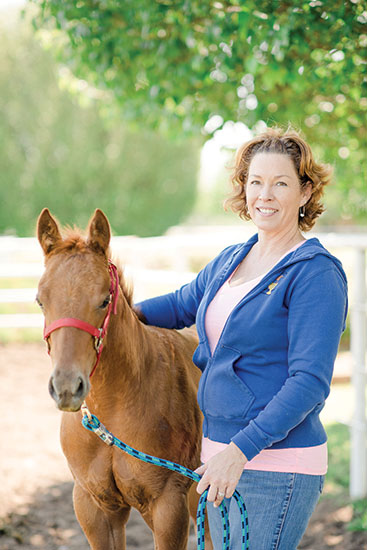
Katie Mitchell
A finished, polished look in the show arena includes considering every last detail on both horse and rider. Since white markings particularly on your horse’s legs stand out to the eye, impeccable grooming of these areas are essential for a winning appearance. Seasoned professional horsemen share their tips on how to finish white markings correctly in both Halter and Performance events.
When it comes to making white legs look really white, multiple World Champion Halter trainers JT and Katie Mitchell of Pilot Point, Texas suggest first and foremost washing the leg thoroughly.
“I like clean pink legs,” said Katie Mitchell. “I use purple shampoo on white areas. They are all good. Pick one you like. My key strategy for nice legs is to coat on the Show Sheen or Vetrolin Shine Spray after the bath. I mean COAT it on, like its running down the coronet band. Let the horse stand in its stall to dry. This makes my clip job so much easier.”
Also, multiple World Champion Western Pleasure trainer Mike Hachtel of Collinsville, Texas suggests washing white legs well before clipping them because it is not only easier on the clipper blades but it also leaves fewer clipper marks.
“The trick with white legs is a really good clipping job because, if the hair is long, it’s not going to look as white,” he said. “At regular horse shows, I typically use a 30 or 40 blade but when showing at the World Show I try to get the hair as tight as I can typically using 50 blades.”
Even though Mitchell typically too uses a 30 blade for weekend shows and suggests using a good 40 blade a couple weeks before a big show, she cautions using a tighter blade if you are not a seasoned clipper.
“I have been clipping a long time so I have mastered fixing my own mistakes,” she said. “I can turn the clippers upside down or increase my blade to a 40 and use delicate pressure to fix any track marks but be careful with the 40 blade if you are new to clipping.”
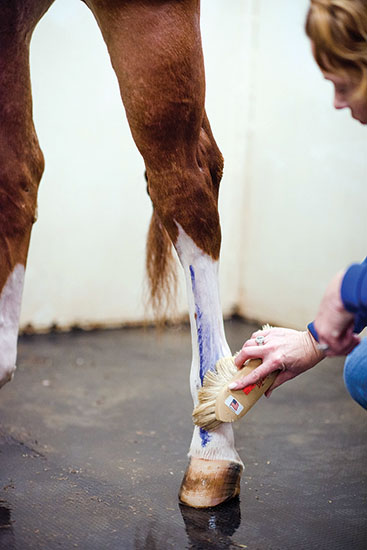
Similarly, for AQHA Professional Horseman and multiple World Champion Hunter Under Saddle rider, Keith Miller of Reidsville, North Carolina there are no short cuts when it comes to making white legs look white.
“I like to wash all legs first, then clip white legs with a 30 blade, four days prior to showing,” he said. “We like to clip shorter because it makes getting them clean after showing a lot easier. We have found that we have less problems with scratches if the hair is kept shorter and we wash after every show day so we make sure all products (leg spray, poultice, fly spray, etc.) is off.”
Then after the hair is clipped, Mitchell suggests rinsing the white legs off again.
“Remember that pink skin is delicate, we just clipped all the hair off, the clippers were warm and the tiny hairs we cut stick to the leg and can potentially break into the skin and cause an infected area like an ingrown hair. A cold water rinse solves all these issues,” she said. “Spray lightly again with Show Sheen or Vetrolin. If you go to an overnight show and you have to longe or practice in the dirt just take them over to the wash rack and rinse their feet and legs off before you put them up.”
In addition, Mitchell highly recommends rinsing white legs off regularly at home after working your horse.
“You have to be aware of White Line disease in certain climates but we personally have never had large issues with it,” she said. “We keep the bedding clean and dry so any rinsing of legs or feet is soaked up.”
Clipping white legs well and keeping them clean will also make using products like baby powder or leg spray more effective because these products are easier to apply according to Miller.
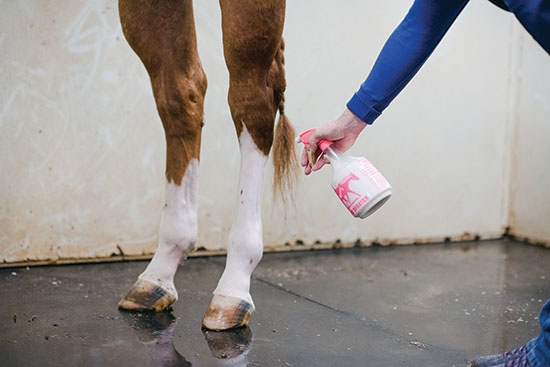
“I think clean, well-groomed white legs are a great first impression,” he said. “But I think this is true for a solid marked bay horse as well. Good turn out should apply for all horses but it is more noticeable on a white legged horse.”
However, Mitchell warns overusing products on white legs because the effect can become distracting to the eye.
“A white leg will always look naturally larger than a dark leg,” she explained.
In turn, she prefers a clean pink sock over markings that have been over coated with products to be made extra white. In some cases, she proclaims products like baby powder can help a scarred area on a white leg.
“Some people choose to do it to hide scar marks, especially on older horses,” she said. “That is fine. Judges are not supposed to penalize a horse on scars or old wounds- that aren’t part of structural incorrectness. But clean appearance is everything and if it helps cover or blend dark marks on pink skin that is great. What I don’t like is a bunch of coated, caked-on goop. It’s distracting like a woman with too much makeup.”
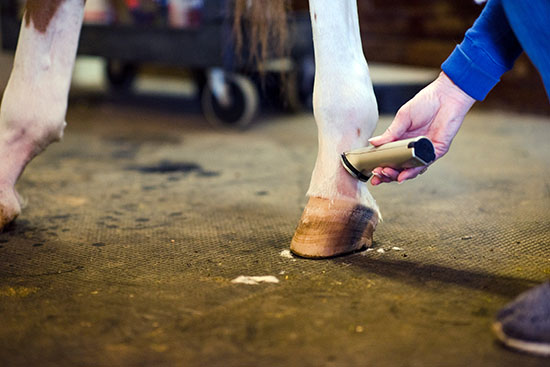
When finishing white markings on legs properly it is also essential to consider how its white hoof should be addressed.
In Halter classes, Mitchell prefers using hoof black on their white feet for a more finished look.
“I enjoy the look of black feet, because that is how I have always seen it in the Halter ring,” Mitchell said. “I don’t think any judges will penalize an oil footed horse. I just think the black gives you that finished, polished look.”
Quite conversely in the Western Pleasure ring, Hachtel does not black feet on his white legged color breed horses at all.
“I don’t want to draw attention to the foot on a pleasure horse and black draws your eye to the foot instead of the movement of the leg,” he said. “Therefore, I always go with a clear polish on my white legged horses.”
And in Miller’s opinion, white legs can look good with either oil or black hoof polish depending on the horse.
“I have some that look goofy with black hooves, so they get oil,” he said, “and other white-legged horses on which we always use hoof black. And I can’t figure out what makes black or oil more appropriate for each horse-it’s just a personal preference for that individual.”
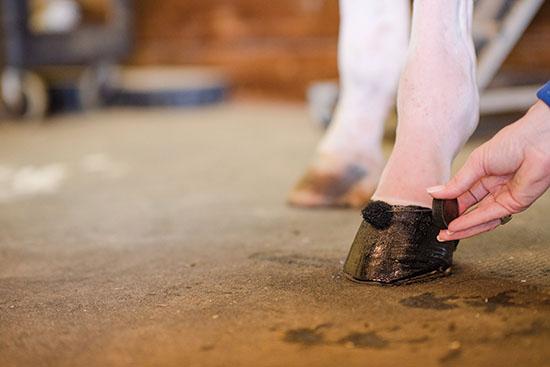
Particularly in Halter, a well-groomed white leg and foot is truly essential for success. According to Mitchell, a white leg can give the appearance of being swollen or puffy which in turn can lead the judge on to believe the horse has a conformational flaw.
“White legs are tough enough for judges, as sometimes that white will travel up into the hock joint and give an optical illusion of a bad angle,” she said. “A white leg will also draw your eye to the white area. That is why I prefer a clean pink leg. It’s clipped. It’s clean and your eyes are not focused on white paint. It gives a more blended look while still showing off your grooming skills.”
Similarly, Hachtel suggests being aware of your horse’s white markings and how appealing they are to the eye while moving down the rail.
“Depending on how that particular horse moves depends on if you want to draw attention to the white markings on its legs,” he said. “For example, in some situations you may not want to clip the white as tight above the knee if you don’t want to draw a lot of attention to the white there.”
Although Miller also believes that white legs can alter the way our eyes perceive movement, he does not let it stop him from buying a horse for a client.
“When I’m looking for a new horse, I like one that has a lot of presence and often the white legs do that,” he said.



You must be logged in to post a comment Login